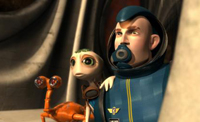Watching Battle for Terra, the latest computer-animated 3D offering, is little like stepping into a breathtaking cathedral in a strange city and finding a church play going on in the middle of it. The drama may be competently done, but it’s the least interesting thing in the room. You keep looking past the action, stealing glances to one side or the other, absorbed in the splendor of the setting. Earnest as the players are, the moralizing story draws you in only fitfully, and most of the time you’d rather steal away and just wander aimlessly from one corner to another, taking it all in.
Give writer-director Aristomenis Tsirbas and co-writer Evan Spiliotopoulos credit: Not only have they pulled off an exercise in visionary world-building warranting comparison to Miyazaki—and without the backing of a major studio—they’ve crafted an uncompromising, hard sci-fi parable in a genre, computer-animated fantasy, dominated by comedy, mostly with anthropomorphic animals and such. In its own way, Battle for Terra is as daring as WALL-E, and if it isn’t as accomplished or satisfying, the story and the science make a lot more sense.
The first few minutes, before the story gets rolling, are mesmerizing. The alien world on which Battle for Terra is set is a sort of aerial seascape, with flora and fauna inspired by aquatic Earth species, but without the water. A winged fish hovers like a hummingbird, seaweed-like forests stretch skyward and broad-leafed plants dangle long stems like water lilies in an invisible lake.

An awesome whale-like creature, disconcertingly referred to by one of the locals as a “sky whale” (as if our terrestrial species were his reference point as well as ours) soars majestically through the sky like the flying humpbacks from Fantasia 2000‘s “Pines of Rome” sequence. As for the locals themselves, they have vaguely fishy faces and tadpole-like bodies, with floating movements like sea horses.
Sooner or later, though, the story has to be about something, as the filmmakers are all too aware. While it isn’t as obvious in this regard as it might have been—or perhaps the message is simply muddled after various stages of revision—Battle for Terra never gets past feeling like something that’s self-consciously meant to be Good For You.
At first, as we encounter the peaceful but paternalistic alien society, and meet the requisite sassy, independent-minded heroine Mala (Evan Rachel Wood), the sort of free thinker who likes to invent things, explore forbidden areas and gets sent to her room for daring to question the Teachings of the Elders, it looks like it might be about oppressive traditionalism and authoritarianism.

Then, when strange phenomena in the sky—followed by a frightening encounter and a series of abductions—are mistaken by the simple creatures as a matter of “gods” and “miracles,” it looks like the film might become a parody of organized religion. (One of Mala’s inventions, a telescopic lens, establishes her as a pert young Galileo bucking the establishment—a device that goes back to the story’s roots as a seven-minute short.)
But then comes a key moment in which Mala tells her people’s leader, Doron (James Garner), that her father (Dennis Quaid) has been taken by “the gods.” Doron replies simply, “They’re not gods. They’re invaders . . . pretenders. They’re dangerous.” And it turns out that the Terrian leaders aren’t necessarily authoritarians seeking only to keep the masses ignorant and superstitious, etc. In fact, they may be wise and enlightened.
Then the aggressors—is this really a spoiler?—turn out to be, yes, humans, and it’s revealed that mankind has come to this distant world because—surprise surprise—Earth (along with its nearest neighbors) has been destroyed by environmental disasters and war. And flyboy Jim Stanton (Luke Wilson), an initially hostile but eminently enlightenable John Smith to Mala’s Pocahontas, comes to learn that the peace-loving aliens seemingly know nothing of war, and witnesses their “Ceremony of Life,” a politically correct Gaia-esque celebration to “thank Life for what it brings.” (What happened to their gods?)
So it begins to look like Battle for Terra might turn out to be a misanthropic pacifist–environmentalist parable about evil, rapacious Western imperialism versus nature and noble savages. And, again, there’s some of that, though neither side of the equation is quite as simple as that.

Despite the cynical judgment of Stanton’s robotic sidekick Giddy (Kung Fu Panda‘s David Cross) that “everything different scares” humans, mankind isn’t monolithically benighted or oppressive. Civilian leaders urge restraint in dealing with the “Terrians” (as the humans call them, having scoped out their planet as a new Terra). The military does rather take it on the chin, even if a single human being, the villainous General Hemmer (Brian Cox), is essentially scapegoated for mankind’s sins. (Note the “diversity” of the sympathetic civilian leaders—President Chen (Danny Glover), scientist Maria Montez (Amanda Peet)—while Hemmer is of course a white man.)
As for the Terrians, they’re neither as savage nor as innocent as they might seem, and the anti-war motif is balanced by a somber acknowledgement that “Even gentle beings must defend themselves when attacked.” In an idealistic speech that is the opposite of war-is-hell utilitarianism, Doron says something like, “I have to believe that the qualities that make us great can also make us strong, and that love and mercy can triumph over hate and aggression.”
If it’s not as one-sided as it might have been, it’s not as engaging either. The characters never really come to life, and the story, despite a few riveting moments, is more often by the numbers. The human characters even look generic—there’d be no telling Stanton apart from his younger brother if it weren’t for a telltale notch in his left eyebrow—and their clothes move like they’re molded on their bodies, with no folds or hanging.

While the story is more coherent than WALL-E (which isn’t saying much; narratively speaking, practically everything in WALL-E falls down the moment you push on it), its efforts at realism only highlight its lapses. Mala’s people breathe, and the plants of her world exude, something other than oxygen—but then Giddy quickly finds one plant species that exudes oxygen—and one specimen of that plant immediately fills a large oxygen tent with enough 02 to revive a nearly dead Stanton.
Most glaringly, nobody thinks of proposing the oxygen-tent model on a larger scale in time to prevent all-out war. Driven by desperation as the Ark, mankind’s interstellar home (and another visual triumph), slowly breaks apart, Hemmer plans to terraform the new planet into an oxygen environment hospitable to humans but deadly to Terrians—that is, to commit genocide. He even cites mankind’s Judeo-Christian heritage in connection with the terraforming process, which he says would take seven days: “Very biblical, don’t you think?”
The civilian leaders lamely protest that they need more time to debate and vote. Nobody on the Ark thinks to say, “Why don’t we just build a biodome somewhere, at least to start?” This is the “Idiot Plot” fallacy (hat tip: Roger Ebert), in which conflict is sustained by not allowing anyone to propose the obvious solution.
Some well-done action sequences, particularly the climactic battle, recall Star Wars—but Star Wars has already been done. Battle for Terra might have made a deeper impression had it gone more its own way. At its best, it almost does.
Talk About It
Discussion starters- Do you think there could be life on other planets?
- If we encountered a complex alien species in its native environment, do you think we would be able to tell whether they were sub-rational creatures (like animals) or personal, rational, spiritual beings (what the Malacandrans in C. S. Lewis’s Out of the Silent Planet called “hnau“)? Fallen or unfallen? What implications would these possibilities have?
- Would a human being’s moral duty to a rational alien be different from his duty to his fellow man, or the same? How and/or why?
- Mala says, “The elders say for a long time we were apart from nature, but now we’re together forever.” How do you think Mala’s people have changed? How was this change for the better or the worse? Do you think this sort of change is possible or desirable? Why or why not?
The Family Corner
For parents to considerBattle for Terra is rated PG for sequences of sci-fi action violence and some thematic elements. There are a number of battle sequences, and characters, sometimes significant ones, are killed. The story raises significant issues that parents may want to discuss with children: Human characters debate genocide as the only option to save mankind, and in one scene a character forces another character to choose between the death of a relation from his own species or that of a member of the other species who has helped him. Among the Terrians, there is misguided talk of “gods” and “miracles,” and blind trust in “the elders.”
Photos © Copyright Lionsgate/Roadside
Copyright © 2009 Christianity Today. Click for reprint information.












